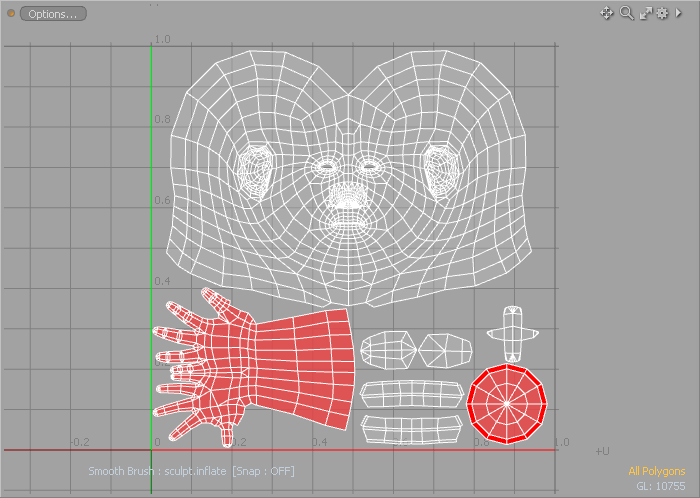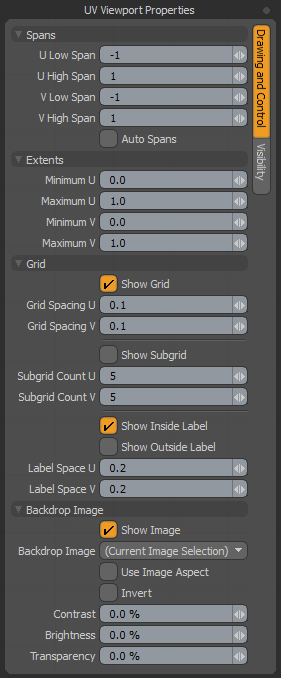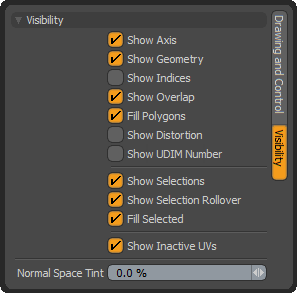
The UV viewport is much like the 3D (OpenGL) Viewport, only instead of representing 3D space, it shows you the two dimensional view of UV space. UV maps are the flat, 2D representations of a model's 3D surface for the application of texture maps (images). If you are not familiar with what a UV map is, you can explore them further on the Working with UV Maps section. The main toolbox and viewport for UV mapping are available in the default UV edit interface. If this tab is not visible, you may select the UV interface using the Layout > Layouts > UV Editor menu command.

Compared to the 3D Viewport, the UV viewport itself is rather sparse. The 3D grid is replaced by the 2D UV grid and flat background color. Relevant on-screen information overlays are still located toward the bottom of the viewport. The Thumb and Widget viewport controls are still available toward the top, for more information on them, see the Layout Controls topic. The pan and zoom navigation widgets are located in the upper-right corner. You can click on these icons to move and scale the contents of the viewport, making it easier to see certain areas for detailed editing. Lastly, you can click the Options capsule-shaped button toward the upper-left corner to open a context menu with a variety of viewport customizing controls, acting as common shortcuts for the same options available in the viewport Properties panel.
Navigation of the UV view is very similar to the 3D views. You can use the zoom and pan widgets to navigate, but you may find it far easier to use the mouse and keyboard combinations below:
• Ctrl+Alt+click - zoom to mouse position.
• Alt+click - pan view.
• Mouse wheel - zoom to mouse position.
• Shift+Alt+middle-click - pan horizontally (U direction).
• Shift+Alt+right-click - pan vertically (V direction).
• Ctrl+Alt+right-click - box zoom (drag to define zoom area).
• A - zoom to geometry extents.
• Shift+A - zoom to selection.
• . (period) or , (comma) - zoom in and out.
• G - center current mouse position.
Modo provides a way for you to modify the visibility of an object in the viewport directly. While, generally, you can toggle visibility of items in the Item List, which changes visibility of the entire layer, commands also allow the temporary toggling of visibility for only selected elements, including components, depending on the selection mode you're using. Once hidden, geometry is un-editable, meaning it cannot be selected or moved. To apply, simply select the geometry component you wish to hide and invoke the menu bar command View > Hide Selected or press the H key. To make the geometry visible again, invoke the View > Unhide command or press the U key. When a file is saved and re-opened later, all hidden polygons are visible.
• H - hide selected (hides all if nothing is selected).
• Shift+H - hide unselected
(hides all unselected geometry).
• Ctrl+H - hide invert (toggles visibility, inverting the present state).
• U - unhide (makes all hidden geometry visible).
Providing a similar function to hiding, locking allows you to fix a selection of geometry so that is immovable and un-selectable, effectively un-editable. However, it is still fully visible. Unlike hiding, this locking function is limited to the component selection modes. To apply, simply select geometry and invoke the menu bar command Edit > Lock Selected or press the J keyboard shortcut. You can unlock any locked element in an item layer with the Edit > Unlock command or by pressing I.
• J - lock selected (locks all if nothing is selected).
• Shift+J - lock unselected (lock all of the unselected geometry).
• Ctrl+J - lock invert (toggles locked state of all geometry).
• I - unlock (makes all locked geometry editable).
You can select from a variety of display customization options from the viewport Properties menu, found by clicking the gear icon in the upper-right corner, or by holding the mouse pointer over the viewport and pressing the O key. Acting as a standard dialog, edits can be made normally. As soon as the mouse pointer moves away from the menu, it disappears. Many of these display options are also available using the Option context menu button in the upper-left of the viewport.

The Spans options are as follows:
• U/V High/Low Spans - control the number of UV sections or spans displayed in the viewport using these controls. Each span represents a complete UV grid section. The default value produce the grid found most commonly in 3D programs representing, the -1 to 1 UV space coordinates. You can place vertex data anywhere within UV space; this option simply determines the display extent of the UV grid.
• Auto Spans - The Auto Spans option only draws the visible grids inside the UV viewport, updating as you pan.
The Extents options are as follows:
• Minimum/Maximum U/V - you can control the active area for UV mapping using the Extents options.
The Grid options are as follows:
• Show Grid - this toggle determines the visibility of the UV grid in the viewport.
• Grid Spacing U/V - you can set the grid line spacing using these values, defined as decimals of the UV unit. The default value of 0.1 draws grid lines every 10th of a unit.
• Show Subgrid - for detailed maps, the standard grid may not have enough sub-divisions to be visible when zoomed in; you can enable this setting to display a lighter secondary grid.
• Subgrid Count U/V - these options determine the number of divisions between each Grid sub-division.
• Show Inside Label - this option toggles the visibility of grid value labels inside the grid area.
• Show Outside Label - this option toggles the visibility of grid value labels outside the grid area.
• Label Space U/V - these values determine the division level for the grid labels. Typically this value matches or is a division of the Grid Spacing value.
The Backdrop Image options are as follows:
• Show Image - allows you to toggle the visibility of a background reference image map. The particular image displayed is determined by the Backdrop Image settings.
• Backdrop Image - the Backdrop Image option offers you the ability to select from a list of loaded images (those that are available in the Clips/Image list) or when the option is set as Current Image Selection, whatever the current image selected. Images can be selected in the Images tab or within the Shader Tree.
• Use Image Aspect - it's a common misconception that UV-mapped images need to have equal height and width. Regardless of aspect or resolution, images render and display correctly. When enabled, the Use Image Aspect option, the UV window, is scaled horizontally to match the aspect ratio of the selected image, making it easier for you to edit UV maps for non-square aspect ratios.
• Invert - simply inverts the RGB color values of the backdrop image, producing a negative effect.
• Contrast - the apparent visual difference between light and dark values in an image. Values greater than 0% increase the contrast of the backdrop image, while values lower than 0% decrease it.
• Brightness - the degree or amount of light or luminosity in an image. Values greater than 0% increase the brightness of the backdrop image, while values lower than 0% decrease it.
• Transparency - determines the opacity of the backdrop image. Values greater than 0% increase the transparency, ramping toward 100%, where the image becomes completely invisible.

The Visibility options are as follows:
• Show Axis - this option toggles visibility of the colored axis display at the UV origin.
• Show Geometry - this option toggles visibility of all geometry in the viewport.
• Show Indices - this option toggles visibility of vertex index value for selected items.
• Show Overlap - when the area of a polygon sits over the area of another, enabling this option displays a red highlight to indicate the overlapping state. Avoid overlapping when baking as it causes rendering errors, but often times for texturing game models, it is desirable.
• Fill Polygons - this option toggles visibility of the faint fill coloring given to polygon faces.
• Show Distortion - two main goals when UV mapping are to eliminate or reduce seams, and to minimize distortion from stretching. Unfortunately, these two are not mutually exclusive. Distortion often happens with UV mapping. Enabling this option displays a color overlay on the geometry, fading toward red when polygons are distorted and smaller (relative to other polygons in the map) and fading toward blue when they are distorted and larger (relative to other polygons). Polygons that are the closest relative size to others in the map with the least distortion display a middle gray/green color. You can also display the distortion colors in the 3D Viewport by selecting the Vertex Map viewport style and then selecting the UV Distortion named Vertex Map, generated under the Other Maps heading of the Vertex Map Lists viewport.

When Show Distortions is enabled, colors overlay onto the geometry signifying distorted areas of the UV map:
• Show UDIM Number - this option toggles the displays the UDIM address at the center of each UDIM tile.
• Show Selections - this option toggles visibility of highlighted polygon selections (by default, an orange color).
• Show Selection Rollovers - this option toggles visibility of selection rollover pre-highlighting.
• Fill Selected - this option toggles visibility of the orange fill color for selected polygons.
• Show Inactive UVs - this option toggles the visibility of UV maps for items in the background (visible but not selected in the Items list).
• Normal Space Tint - the Normal Space Tint option controls the amount of tint coloration applied to the Normal Space area of the UV viewport, identifying the central or main UV area of 0 to 1. This is where textures originate; outside of this area the texture simply tiles.